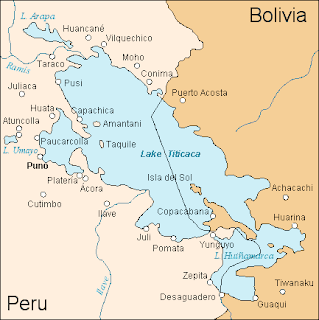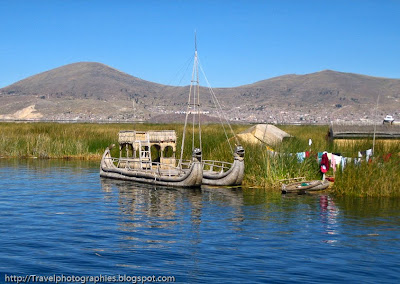Lake Titicaca : Uros Islands
Titicaca lake is the highest lake in the world, where its peaks is at around 3810 meters. It covers some 8562 km², and it's separated in the middle by the frontier between Peru and Bolivia.
(source: wikipedia)
So far, most of tourists start their tour from the city of Puno. I didn't take many photos in Puno. Nothing except its traditional "plaza de armas" and cathedral, nothing really retained my attention.
I noticed two things in Puno.
1st thing concerns the climate. In May, even if temperatures look good to people coming from north hemisphere, in Peru, it's winter.
In Puno, due to its high height, in the morning, when you wake up, it's almost freezing outside, and it happens often to see ice on the lake. And, slowly, as sun rises up in the sky, temperatures are warming and by the afternoon, you feel hot, until sunset and dark comes back.
As we hear often, there are only two seasons in Puno.
2nd thing concerns the lake itself. Because of tourism, all these boats to see the Uros islands and Taquile reject too many pollution, and we have to go further to see water without foam. What should we do ? help Peruvian government to clean the lake, and use green fuel to prevent other foaming formation. Or don't go anymore to Peru ?
Peru has to face a huge problem: mass tourism brings a lot of money but it doesn't help to protect environment and places like Machu Picchu from degradation.
Anyway, when we're approaching Uros islands, we finally appreciate this nice landscape:
Uros islands are islands built by indians living in the lake. They used to be part of the Uros tribe, but it is said that the last descendant of this tribe deceased in 1959. Indians now living in these islands are part of the Aymaras tribe.
In the map above, the green zone covers territories where the Aymara language is spoken (courtesy of wikipedia).
Islands are made of reeds.
Uros indians traverse the lake with their boat made of "totora" (choenoplectus californicus ssp. tatora) is a subspecies of the giant bulrush sedge)
Our modern world meets the Uros world: thanks to tourists, Uros inhabitants can preserve their way of life, but must conciliate it with folkloric animations to please tourists. Is this looking real and natural to tourists?
I wonder how they are really living when they are no tourists, if by chance, tour operators let them free time.
(source: wikipedia)
So far, most of tourists start their tour from the city of Puno. I didn't take many photos in Puno. Nothing except its traditional "plaza de armas" and cathedral, nothing really retained my attention.
I noticed two things in Puno.
1st thing concerns the climate. In May, even if temperatures look good to people coming from north hemisphere, in Peru, it's winter.
In Puno, due to its high height, in the morning, when you wake up, it's almost freezing outside, and it happens often to see ice on the lake. And, slowly, as sun rises up in the sky, temperatures are warming and by the afternoon, you feel hot, until sunset and dark comes back.
As we hear often, there are only two seasons in Puno.
2nd thing concerns the lake itself. Because of tourism, all these boats to see the Uros islands and Taquile reject too many pollution, and we have to go further to see water without foam. What should we do ? help Peruvian government to clean the lake, and use green fuel to prevent other foaming formation. Or don't go anymore to Peru ?
Peru has to face a huge problem: mass tourism brings a lot of money but it doesn't help to protect environment and places like Machu Picchu from degradation.
Anyway, when we're approaching Uros islands, we finally appreciate this nice landscape:
Uros islands are islands built by indians living in the lake. They used to be part of the Uros tribe, but it is said that the last descendant of this tribe deceased in 1959. Indians now living in these islands are part of the Aymaras tribe.
In the map above, the green zone covers territories where the Aymara language is spoken (courtesy of wikipedia).
Islands are made of reeds.
Uros indians traverse the lake with their boat made of "totora" (choenoplectus californicus ssp. tatora) is a subspecies of the giant bulrush sedge)
Our modern world meets the Uros world: thanks to tourists, Uros inhabitants can preserve their way of life, but must conciliate it with folkloric animations to please tourists. Is this looking real and natural to tourists?
I wonder how they are really living when they are no tourists, if by chance, tour operators let them free time.











Comments